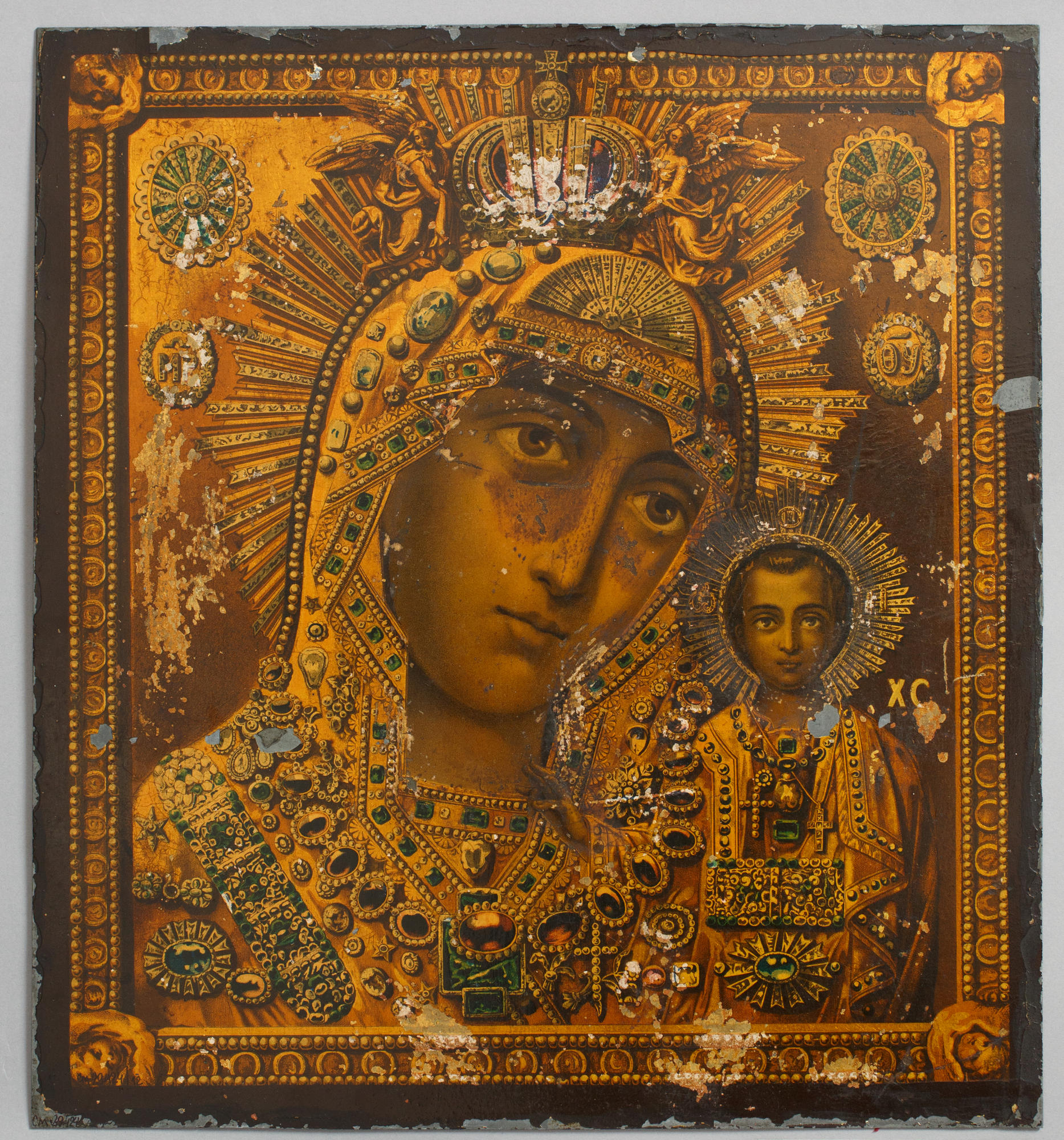The exhibited icon of Our Lady of Kazan is an icon from the Kazan Cathedral in S.-Petersburg. It was created using the technique of print on metal – such icons were common after the revolution in the emigrant community abroad.
1 / 2
Icon of Our Lady of Kazan
Creation period
Late XIX – early XX centuries
Dimensions
21,5x17,5 cm
Technique
Print on metal
5
Open in app#1
Unknown Author
Icon of Our Lady of Kazan
#2
#4
The image is of the Hodigitria type, traditional for Byzantine art.
#5
It is characterized by the portrayal of the Virgin Mary holding Christ child in her arms – He is giving blessing with his two fingers.
#6
Theotokos is portrayed on the icon wearing traditional vestments. Her image emanates both grandeur and monastic humility.
Ancient icons were framed in icon plating and frames made from metal: gold and silver for expensive ones and copper, brass and tin plate for more modest icons. They were decorated with precious stones, beads, enamel or colored glass.
Ancient icons were framed in icon plating and frames made from metal: gold and silver for expensive ones and copper, brass and tin plate for more modest icons. They were decorated with precious stones, beads, enamel or colored glass.
#8
The prototype of the icon of Our Lady of Kazan appeared in Kazan in the XVI century when a devastating fire happened in the city. According to the legend, soon after it the daughter of a local merchant saw the Theotokos in her dream. The Holy Virgin pointed to her the place where the icon was and in 1579 citizens found the icon, untouched by the fire, under a layer of ashes.
Stories of miracles are connected with the icon of Our Lady of Kazan: it was said to heal from headaches, return vision to the blind, protect the city from enemy invasion. Replica of the icon appeared later in churches and monasteries of the country – repetitions of the image without exact copying, – that were also revered among people.
#9
Later the first Kazan icon was lost. According to one version, the orthodox relic was kept in the Monastery of the Holy Virgin in Kazan and was stolen from there in 1904 together with the icon of the Savior. Images in frames with precious stones were very expensive, and the thieves were not detained by its spiritual value.
The thief was soon found. Peasant Varfolomei Chaikin testified under investigation that he had sold the frame and put the icon in a furnace – it was burnt to ashes. Later he changed his testimony several times, giving rise to legends that the icon survived – the thief sold it together with the frame. However, most historians agree that the icon perished in the fire.
The thief was soon found. Peasant Varfolomei Chaikin testified under investigation that he had sold the frame and put the icon in a furnace – it was burnt to ashes. Later he changed his testimony several times, giving rise to legends that the icon survived – the thief sold it together with the frame. However, most historians agree that the icon perished in the fire.
#10
This icons is an exact copy of the image of Our Lady of Kazan on metal that Elisabeth Feodorovna blessed and presented to the hegumen Seraphim (Kuznetsov) allegedly in 1914. Shortly before his death, Father Seraphim sent the icon to the Grand Duchess’ niece he knew of, the Queen of Sweden Louise Mountbatten; the later ordered Prince Louis of Hesse and by Rhine to hand the icon over to the St. Mary Magdalene Church in Darmstadt in 1960.
The sacred image was greatly revered by Grand Duchess Elisabeth Feodorovna. The similar original icon kept in the St. Mary Magdalene Church in Darmstadt was executed by an unknown master.
The sacred image was greatly revered by Grand Duchess Elisabeth Feodorovna. The similar original icon kept in the St. Mary Magdalene Church in Darmstadt was executed by an unknown master.
#11
Sverdlovsk State Regional Ethnography Museum
read morehide
00:00
00:00
1x
Icon of Our Lady of Kazan
Creation period
Late XIX – early XX centuries
Dimensions
21,5x17,5 cm
Technique
Print on metal
5
Open in app
Share



